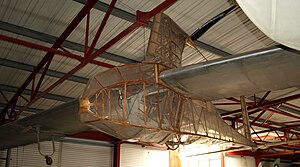The Southampton University Man Powered Aircraft (orSUMPAC) on 9 November 1961 became the first human-powered aeroplane to make an officially authenticated take-off and flight.[1] It was designed and built by Southampton university students between 1960 and 1961 for an attempt at the Kremer prize, but it was never able to complete the 'figure-of-eight' course specified to claim the prize money.[2]
| SUMPAC | |
|---|---|

| |
| SUMPAC on display at the Solent Sky museum. | |
| Role | Human-powered aircraft |
| First flight | 9 November 1961 |
| Number built | 1 |
The aircraft was designed and built by a team of post-graduate students from Southampton University. Intended to compete for the £50,000 Kremer Prize (requiring successful completion of a one-mile (1.6 km) 'figure of eight' course) the project was funded by the Royal Aeronautical Society.[2]
The aircraft is of conventional configuration, with the exception of a pylon mounted pusher propeller, and is constructed from balsa, plywood and aluminium alloy. Originally covered with silver-doped Nylon the aircraft now sports a transparent plastic skin on the fuselage.
The SUMPAC was powered using pedals and chains to drive a large two-bladed propeller. Piloted by noted gliding instructor and test pilot Derek Piggott, its first flight on 9 November 1961 at Lasham airfield covered a distance of 70 yards (64 m) and climbed to a height of six feet (1.8 m).[2] The longest flight made was 650 yards (594 m) rising to a maximum height of 15 ft (4.6 m). Turns were attempted, with 80 degrees the best achieved. A total of 40 flights were made by SUMPAC.[3] After a crash in 1963 which caused damage to the fragile structure it was decided to retire the aircraft although it had been repaired.[2]
The SUMPAC is currently on display at the Solent Sky museum; it was loaned for some time to the Shuttleworth Collection but now resides in its hometown of Southampton.
Data from The World's Sailplanes:Die Segelflugzeuge der Welt:Les Planeurs du Monde Volume II[2][4][5]
General characteristics
Performance
Aircraft of comparable role, configuration, and era